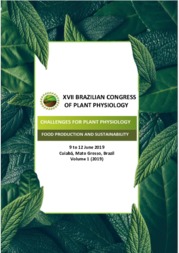Chlorophyll a fluorescence in young Bertholletia excelsa BONPL. plants subjected to different shading levels.
Chlorophyll a fluorescence in young Bertholletia excelsa BONPL. plants subjected to different shading levels.
Autoria: SILVA, K. N. C.; MAGOSSO, B. F.; MULLER, G. V. M.; PIZZATTO, M.; SANTOS, L. B.; BEHLING, M.; FELIPE, R. T. A.; SILVA, A. C. da
Resumo: Photochemical responses are directly dependent on the level of incident solar radiation during the initial establishment of forest species. The aim of the current study was to evaluate chlorophyll a fluorescence in 2-year-old Bertholletia excelsa seedlings from July to October 2017. Samples were acclimated on polyolefin screens under different quantitative (35%, 50%, 65% and 80%) and qualitative (thermo-reflective, red, blue and green screens, at 50% solar radiation attenuation) shading levels and under full sun at the 77th, 105th, 122nd and 150th days after acclimation - DAA - (73 days) in Sinop County - MT. Estimates of effective quantum yield (ΦPSII) and electron transport rate (ETR) were performed in the OS5p Fluorometer (150 μmol m-2 s-1 PAR). The experimental design was completely randomized in factorial arrangements (5 x 4) and (6 x 4) (shading levels x time), with three repetitions (seedling). Data were subjected to analysis of variance, at 5% and 10% significance levels. There was significant interaction between shading and time; the maximum ETR (38.26 μmol m-2 s-1) and ΦPSII (0.77) points were estimated at the 116th DAA, at 77% and 76% shading levels, respectively. Red and green screens increased fluorescence parameters throughout the growth period. Seedlings showed low ability to differentiate changes in the quality of the intercepted light, however, those acclimated under full sun were less efficient to photochemically dissipate light energy. We conclude that intermediate shading levels (50% and 65%) increase the efficiency of Brazil nut tree seedlings in converting solar energy into chemical energy.
Ano de publicação: 2019
Tipo de publicação: Resumo em anais e proceedings
Unidade: Embrapa Agrossilvipastoril
Palavras-chave: Bertholletia Excelsa, Brazil nuts, Electron transport chain, Mato Grosso, Sinop
Observações
1 - Por padrão são exibidas publicações dos últimos 20 anos. Para encontrar publicações mais antigas, configure o filtro ano de publicação, colocando o ano a partir do qual você deseja encontrar publicações. O filtro está na coluna da esquerda na busca acima.
2 - Para ler algumas publicações da Embrapa (apenas as que estão em formato ePub), é necessário ter, no celular ou computador, um desses softwares gratuitos. Sistemas Android: Google Play Livros; IOS: iBooks; Windows e Linux: software Calibre.
Acesse outras publicações
Acesse a Base de Dados da Pesquisa Agropecuária (BDPA) para consultar o acervo completo das bibliotecas da Embrapa.

